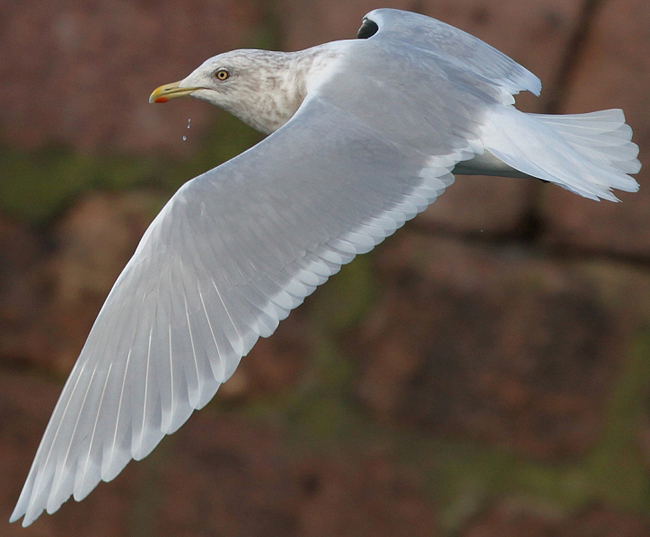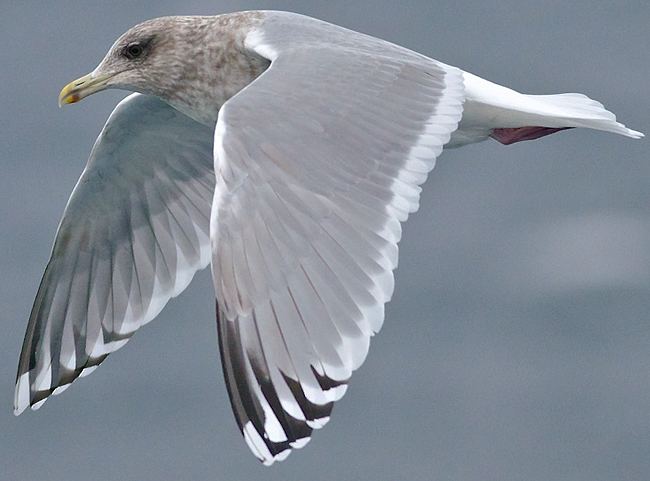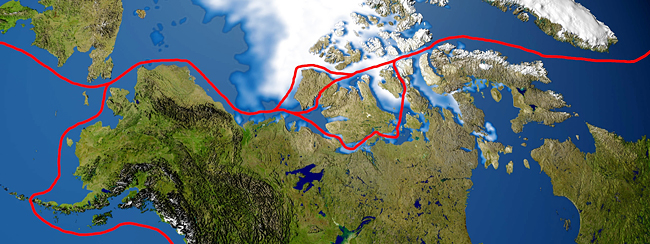 Thayer's Gull (thayeri)
Thayer's Gull (thayeri)
(last update: January 22, 2013)
Thayer's Gull adult October
In 2000, an extensive paper appeared in the Journal for Zoology, dealing with hybridisation and occurance of breeding Thayer's, Kumlien's and Iceland Gull.
The full title reads: Hybridization and changes in the distribution of Iceland gulls
(Larus glaucoides/kumlieni/thayeri),
by D. N. Weir, A.C. Kitchener and R. Y. McGowan,
IN: J. Zool., Lond.(2000) 252, 517-530.
The authors work for the Department of Geology & Zoology, National Museums of Scotland, Chambers Street, Edinburgh EH1 1JF, UK.
"we" in the text below refers to the original authors. If any errors occur in this text, please let me know and mail to marsmuusseatgmaildotcom.
Hybridization and changes in the distribution of Iceland gulls
(Larus glaucoides/kumlieni/thayeri)
Abstract
Three Iceland gull taxa were defined mainly from adult wingtip melanism. Up until about 1860, nominate glaucoides (no melanism) was known to breed from Greenland to western High Arctic Canada, but by about 1900 it was essentially confined to Greenland. Until 1860, thayeri (most melanism) was known only from western High Arctic Canada, but from 1900 to 1980 it was found throughout High Arctic Canada and in a small part of north-west Greenland. At high latitudes in Canada it replaced glaucoides, with which it was formerly sympatric in the west and probably interbred. The first known kumlieni (intermediate, variable melanism) were from west Greenland in the 1840s, and by 1900 the western and northern limits of most of its breeding range in the eastern Canadian Low/High Arctic were known. The range of kumlieni lies between those of thayeri and glaucoides and overlaps both; kumlieni bred in Greenland by 1964. It freely interbreeds with thayeri and probably with glaucoides. Winter ranges of glaucoides and thayeri have changed little since they were first determined for glaucoides by 1860 and for thayeri by the 1920s. However, winter adult kumlieni was unknown from Greenland to the British Isles until 1900; there were a few records prior to 1915 and progressively more after 1950. The study adds to the evidence that kumlieni represents introgressive hybridization by western thayeri into eastern glaucoides.
INTRODUCTION
The Iceland gull Larus glaucoides Meyer 1822 is an Arctic species, which is presently regarded as comprising three subspecies: L. g. glaucoides from Greenland; L. g. kumlieni mainly from Baffin Island; and L. g. thayeri mainly from High Arctic Canada. However, relationships between the Iceland gull and herring gull L. argentatus and between Iceland gull taxa have been debated for 180 years (E. Sabine, 1819, 1824; MacGillivray, 1824; Swainson & Richardson, 1831; Kumlien, 1879; Dwight, 1906, 1917, 1925; Brooks, 1915; Taverner, 1933; Rand, 1942; MacPherson, 1961; Smith, 1966; Knudsen, 1976; Weber, 1981; Gaston & Decker, 1985; Godfrey, 1986; Snell, 1989, 1991a, 1993; Chu, 1998). Iceland gull taxa have been treated as varieties or subspecies of the herring gull or of the glaucous-winged gull L. glaucescens, or as separate species, or as three taxa of one species.
During the twentieth century the frequency of kumlieni in winter adult Iceland gull populations greatly increased in the eastern Atlantic (Weir et al., 1995). This suggestion of instability in the distributions of two taxa prompted us to review distribution data for all three taxa, from the earliest reference to the Iceland gull in 1771 (Winge, 1898) to the present day. Our aim was to investigate the relationships and validity of the taxa from any changes in their respective distributions over time. Unstable distributions may indicate genetic instability and possible hybridization (Barton, 1989).
We defined taxa essentially from variations in the degree of adult wingtip melanism and noted relationships with colours of some soft parts. Non-correlated combinations of these features are usually good indications of hybridization between other species of large, white-headed Larus gulls, although in one case reduced wingtip melanism in a new population might have been due to a founder effect (Patten & Weisbrod, 1974; Harris, Morley & Green, 1978; Ingolfsson, 1970, 1987, 1993; Snell, 1991a,b, 1993; Bell, 1996; Chu, 1998). Our arbitrary, operational definitions of taxa based on published descriptions were necessary for this morphological study and imply no pre-judgement of the genetic relationships between them.

glaucoides adult, January 28 2012, Peterhead, Scotland. Picture: Chris Gibbins.

kumlieni adult, February 07 2007, St John's, Newfoundland, Canada. Picture: Chris Gibbins.

thayeri sub-adult, February 11 2012, Pelagic off Lewes, DE. Picture: Adrian Hinkle.
DEFINITIONS OF TAXA
Differences in extent and intensity of upper surface wingtip melanism and other external characters of adults for three operationally defined taxa of the Iceland gull are presented in Table 1. Wingtip melanism varies more or less continuously from none in glaucoides to darkest and most extensive in thayeri (Dwight, 1925; FjeldsaÊ & Jensen, 1985; Snell, 1989). There is consequently overlap or only marginal separation between taxa (Table 1). Nominate glaucoides has been defined as lacking any wingtip melanism from E. Sabine (1819); to Boertmann (1994), but melanism varies geographically in the other two taxa (MacPherson, 1961; Ingolfsson, 1967, 1970; Knudsen, 1976; Fjeldså & Jensen, 1985; Gaston & Decker, 1985; Snell, 1989).
Wingtip melanism and bill size in Iceland gulls were not correlated in partly sympatric thayeri and kumlieni (Snell, 1989). Wing and tarsus length and bill size did not differ significantly between winter samples of kumlieni and glaucoides measured in Iceland, the Faroe Isles and the UK (Weir et al., 1995), but kumlieni was slightly larger-billed than glaucoides in other samples measured (Dwight, 1906, 1925; Rand, 1942; Ingolfsson, 1967).
Iris colour and wingtip melanism tend to be correlated in breeding adult Iceland gulls (Table 1). The iris colours for Iceland gulls (Table 1) are from mainly allopatric populations; the relationship between colour of iris and wingtip melanism breaks down where sympatric thayeri and kumlieni freely interbreed with each other (Gaston & Decker, 1985; Snell, 1989).
Although not wholly satisfactory, wingtip melanism is the best character for distinguishing between the Iceland gull taxa. Genetic differences between these and other taxa of large white-headed Larus gulls are extraordinarily slight and probably all at sometime interbreed with one or more other taxa (Ingolfsson, 1970, 1987, 1993; Snell, 1991a,b, 1993; Bell, 1996).
| Features | thayeri |
kumlieni |
glaucoides |
| Number of primaries with melanism | (3)4-6 |
1-5 |
0 |
| Melanism scores P 10-6 | 2.0-4.5 |
0.2-2.5 |
0 |
| Iris colour of breeding adults | dark
(purple/brown speckling) |
intermediate |
clear greyish-yellow |
Sources: Dwight, 1906, 1917, 1925; Salomonsen, 1950; MacPherson, 1961; FjeldsaÊ & Jensen, 1985; Godfrey, 1986; Ingolfsson, 1967, 1970; Snell, 1989, 1991a, b; additional Iceland gull data by us from specimens, after Snell (1991b).
METHODS
We examined possible changes with time in the wingtip melanism of adult Iceland gulls throughout their geographical range. We also examined stability of distribution of other large gulls of the region, in case changes were due to a common set of external variables. Because L. a. smithsonianus is readily confused with thayeri and may interbreed with Iceland gulls, we examined old records of `herring gulls' at high latitudes.
We assigned specimens and published records to our definitions of taxa, but differences in definition have occurred between us and other workers. Sight records were often problematical. We excluded most records of immature Iceland gulls because they are highly variable and we knew of no reference specimens of known-origin older than newly fledged juveniles (Weir et al., 1995). We list collections where we examined specimens or from which we sought data (Table 2). Specimens examined for this paper and Weir et al. (1995) differ from those examined in other studies of Iceland gulls or Arctic smithsonianus (MacPherson, 1961; Ingolfsson, 1967, 1970; Fjeldså & Jensen, 1985; Godfrey, 1986; Snell, 1989).
The ornithology of the Arctic is so recent that the apparent expansion of a taxon's range over time may be real, an artefact of increasing knowledge or a combination of both. Conversely, a major range contraction with time may be demonstrably real; there may be good specimen evidence that it once bred where it is not now found. Therefore apparent range expansion by one Iceland gull taxon was most likely to be real if it corresponded in space and time to a known range contraction by another.

Northwest Passage routes. Source: Wikipedia.
It was fortunate that Royal Navy (RN) and associated explorations of the Northwest Passage in 1818-60 included studies of natural history (Neatby, 1970) and happened to traverse almost the entire breeding range of the Iceland gull. Most specimens from the earliest of these are now lost but full descriptions of proposed types or some new geographical records remain. As Arctic ornithology became less novel (J. Sabine, 1824; Ross, 1826; Richardson, 1836) there were fewer descriptions for the period c. 1825-50, and very few specimens survive today. However, most specimens from after c. 1850 are still extant. We examined critically the literature from these explorations in which records were mainly for Arctic Canada. There were references to Greenland birds in early Scandinavian literature from the Viking Sagas onwards and these were critically reviewed by Winge (1898).
END OF PART 1
 Thayer's Gull adult, October 09 2015, New Buffalo, Michigan, US. Picture: Amar Ayyash.
Thayer's Gull adult, October 09 2015, New Buffalo, Michigan, US. Picture: Amar Ayyash. Thayer's Gull adult, October 09 2015, New Buffalo, Michigan, US. Picture: Amar Ayyash.
Thayer's Gull adult, October 09 2015, New Buffalo, Michigan, US. Picture: Amar Ayyash. Thayer's Gull adult, October 28 2011, Elwha River, Clallam County, WA USA. Picture: Steven Mlodinow.
Thayer's Gull adult, October 28 2011, Elwha River, Clallam County, WA USA. Picture: Steven Mlodinow. Thayer's Gull adult, October 28 2011, Elwha River, Clallam County, WA USA. Picture: Steven Mlodinow.
Thayer's Gull adult, October 28 2011, Elwha River, Clallam County, WA USA. Picture: Steven Mlodinow. Thayer's Gull adult, October 06 2012, Off Newport, Oregon, US. Picture: Greg Gillson.
Thayer's Gull adult, October 06 2012, Off Newport, Oregon, US. Picture: Greg Gillson. Thayer's Gull adult, October 11 2006, Qualicum Beach, Vancouver Island, BC. Picture: Guy Monty.
Thayer's Gull adult, October 11 2006, Qualicum Beach, Vancouver Island, BC. Picture: Guy Monty. Thayer's Gull adult, October 11 2006, Qualicum Beach, Vancouver Island, BC. Picture: Guy Monty.
Thayer's Gull adult, October 11 2006, Qualicum Beach, Vancouver Island, BC. Picture: Guy Monty. Thayer's Gull adult, October 27 2011, Duluth, Minnesota, US. Picture: Karl Bardon. Much black in wing tip, with complete band on P5 and relatively broad band on P10; there is even a ghost spot on outer web of P4, but note the clean greater primary coverts and tail. Thayeri pattern on P9 combined with broad sub-terminal band.
Thayer's Gull adult, October 27 2011, Duluth, Minnesota, US. Picture: Karl Bardon. Much black in wing tip, with complete band on P5 and relatively broad band on P10; there is even a ghost spot on outer web of P4, but note the clean greater primary coverts and tail. Thayeri pattern on P9 combined with broad sub-terminal band.  Thayer's Gull adult, October 07 2011, Duluth, Minnesota, US. Picture: Karl Bardon. Last phase of complete moult, P10 growing. Much black in wing tip, with nearly complete band on P5 and relatively broad band on P10. Thayeri pattern on P9 combined with broad sub-terminal band.
Thayer's Gull adult, October 07 2011, Duluth, Minnesota, US. Picture: Karl Bardon. Last phase of complete moult, P10 growing. Much black in wing tip, with nearly complete band on P5 and relatively broad band on P10. Thayeri pattern on P9 combined with broad sub-terminal band.Hybridization and changes in the distribution of Iceland gulls (Larus glaucoides/kumlieni/thayeri).
 Figure 1. Breeding records for three Iceland gull taxa c. 1950-95.
Figure 1. Breeding records for three Iceland gull taxa c. 1950-95. Figure 2. Known breeding distribution with dates of first records for three Iceland gull taxa to c. 1900.
Figure 2. Known breeding distribution with dates of first records for three Iceland gull taxa to c. 1900. Figure 3. Breeding records for three Iceland gull taxa c. 1900-50.
Figure 3. Breeding records for three Iceland gull taxa c. 1900-50. Table 1. Definitions of Iceland gull taxa mainly from adult upper surface wingtip melanism based on a variety of sources.
Table 1. Definitions of Iceland gull taxa mainly from adult upper surface wingtip melanism based on a variety of sources. Table 2. Collections in which we examined Iceland gull specimens, or from which we sought data on specimens for this study and Weir et al. (1995).
Table 2. Collections in which we examined Iceland gull specimens, or from which we sought data on specimens for this study and Weir et al. (1995). Table 3. Known or probable identities of 'Iceland gulls' and 'herring gull' from nine Royal Navy and one Hudson's Bay Co. explorations of Arctic Canada, 1818-59.
Table 3. Known or probable identities of 'Iceland gulls' and 'herring gull' from nine Royal Navy and one Hudson's Bay Co. explorations of Arctic Canada, 1818-59. Table 4. Composition by taxon, from wingtip melanism (see text), of autumn to early spring samples of adult Iceland gull
specimens.
Table 4. Composition by taxon, from wingtip melanism (see text), of autumn to early spring samples of adult Iceland gull
specimens.